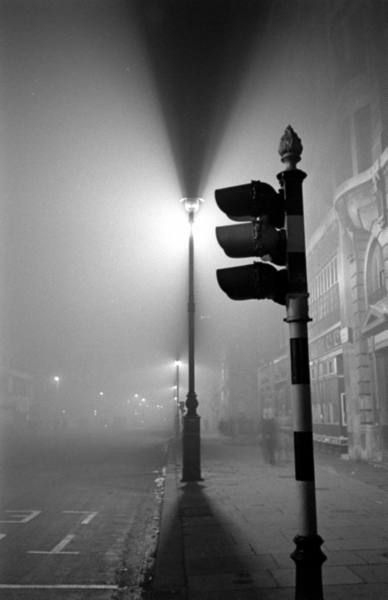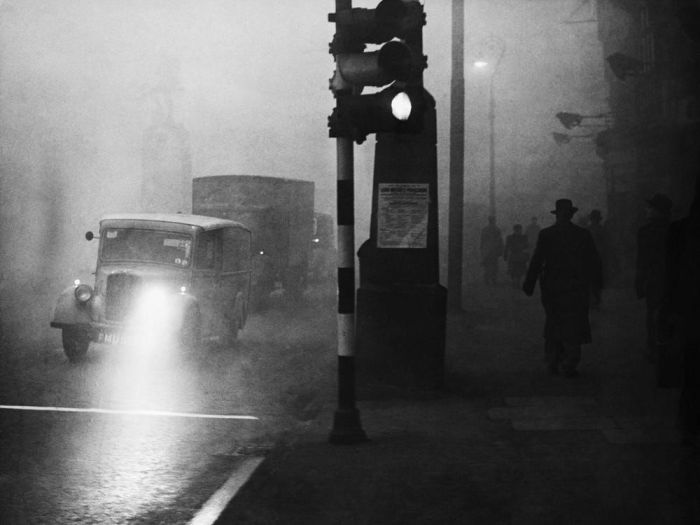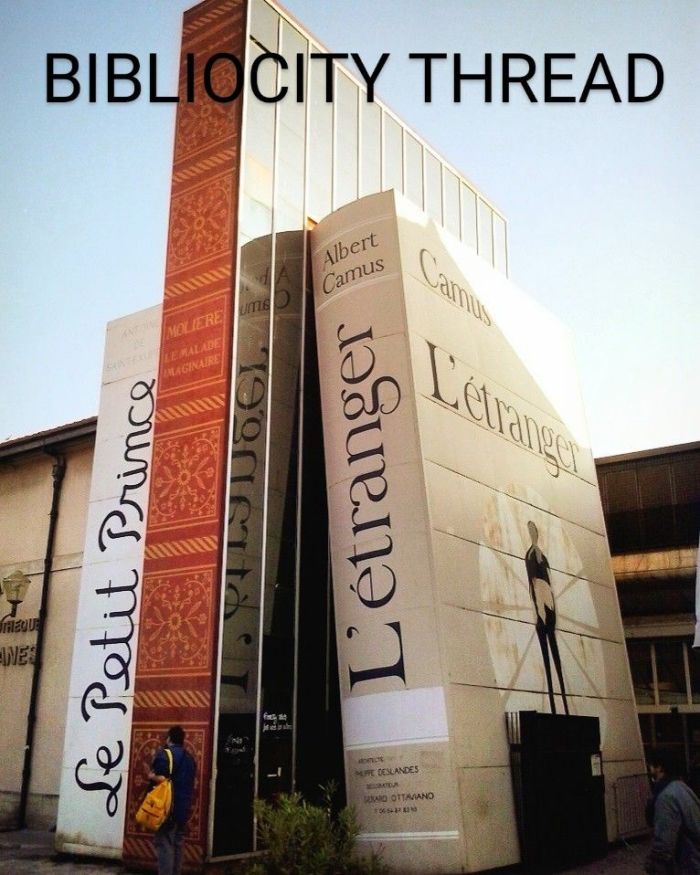
London Particular
by Christianna Brand.
[Also published as Fog of Doubt,
Inspector Cockrill No 5.]
Introduced by P D James.
Pandora Women Crime Writers, Pandora Press, 1988 (1952).
‘In the long, white, firelit drawing-room, the victim bowed and smiled and reeled off his devoirs before the serious work of the evening should begin; within the radius of one fog-bound mile were these seven people, one of whom was very shortly going to murder him.’
— Chapter Four.
In the decades before the first Clean Air Act of 1956 proved pivotal, London’s notorious smogs – a combination of fogs due to the capital’s low lying situation and polluting smoke from household fires and industry – were inconvenient, unpleasant and, especially during the Great Smog of December 1952, very deadly.
Christianna Brand’s crime fiction, set in London’s Maida Vale late one November in the early 1950s, plays on one such smog providing the kind of obscurity that made murder possible, and further allowed suspects the occasion to obfuscate for what they saw as valid reasons.
But who would want to murder a middle-aged visitor from Geneva and, as a layman, how was the stranger able to gasp out in his dying breaths that he had been hit with ‘a mastoid mallet’? It will take a retired police inspector all his experience to approach the truth while severely testing his loyalty to old family friends.

London Particular opens with a pair from the London Welsh community, Rosie Evans and Dr Edwin (‘Tedward’) Edwards, edging slowly through a peasouper in his car towards Rosie’s brother’s house, from which a mysterious telephone call from the murder victim has apparently been made. When they eventually get there, around 9.30 in the evening, Raoul Vernet is indeed found dead; and then the whole household becomes somehow implicated as retired Inspector Cockrill and his former junior Inspector Charlesworth try to penetrate the figurative murk that soon descends around the committing of the crime.
Who are the seven people in the frame? Surely not the seemingly ditzy Rosie who took the call, or Tedward who drove her to the house from his surgery? And what about Rosie’s brother Dr Thomas Evans, who seems to have a reason for killing Monsieur Vernet? Should we rule out Thomas’s wife Matilda who was putting the baby to bed at the time, or dotty old Mrs Evans from upstairs who is arthritic, or Melissa from the basement flat who says she was out in the fog with her boyfriend Stanislas at the time? And where does Rosie’s revolutionary boyfriend Damien figure in the case?
This is such a clever, convincing and even at times humorous murder mystery penned by Brand. We’re presented with lots of opportunities to deduce possible motivations, opportunities and means by which each individual could have ‘done it’, with suspicion transferred from one to another of the seven and back again. And yet, after all the investigations and trial scenes, the scenario is patently obvious right from the start in Chapter One – if only we were only able to interpret it right.

Unlike some Golden Age crime fiction I’ve read, here I got quite invested in the characters, all of whom came over as distinctive and occasionally idiosyncratic. Brand describes them with humour and some fondness but nevertheless remains critical. It turns out that all indeed have different, personal reasons for dissembling, but eventually truth will out. Above all, I found it easy to suspend disbelief, whether in the patient sleuthing, the interviews or the trial scenes, first in the magistrates court and then at the Old Bailey, where tragedy and comedy seamlessly segue and alternate.
In her introduction to this edition fellow crime writer P D James tells us that Brand declared London Particular “her favourite among her novels” and proceeds to list the author’s virtues: “a zest and liveliness which are typical of the writer herself and characters who are observed with an affectionate but unsentimental eye.” (Curiously her generous tribute didn’t stop James misspelling Matilda as “Mathilda” and “shrewd, irascible Kentish detective” Cockrill as “Cockerel”.)
Finally, I return to the title Brand chose for the mystery which, perhaps understandably, was sometimes reissued as Fog of Doubt. ‘London particular’ was an alternative name for the capital’s poisonous yellow peasouper, but I see that ‘particular’ was also slang for ‘a mistress’, which is appropriate in considering certain actors’ motivations; also we know it was the particulate matter from coal fires that were so deadly in London’s smogs. And, as we discover there’ll be more than one deceased, of course death is very much the name of the game.


Bibliocity thread: for this continuing meme I shall be including reviews of books which contain either “city/cities” or the actual name of a city in the title (eg The Last Days of New Paris or Lyra’s Oxford).

London Particular is represented by the clouds, No 16 in Mayri’s Picture Prompt Book Bingo, which I’m interpreting as the smog created by atmospheric inversion and pollution.

I read a huge number of British, Scottish, Welsh, Irish mysteries back when I was consuming them (and Aaron Marc ‘Rod’ Stein, who wrote 115 of them was a friend of my grandparents), and I remember the feeling of London fog fondly (if deadly), so this was a blast from the past.
I also picked up ‘devoirs’ (things he had to do, ie, duties) and ‘mastoid mallet’, so thank you. ‘Deber’ is the Spanish, and it felt familiar, though I hadn’t learned that one in my French classes.
This one sounds as if it would fit right in with the bunch.
LikeLiked by 1 person
As a schoolboy the French word for homework was etched into my brain so I immediately understood the import of mes devoirs in the passage I quoted! And thanks for mentioning Aaron Marc Stein, a name new to me but one I shall keep an eye out for. 🙂
LikeLike
I think Rod used several pen names (George Bagby and Hampton Stone were two I knew), and hope you find a list of his works somewhere. He lived in New York City, and was a Princeton graduate – when I worked at Princeton in the 1980s, I helped him buy and learn to use his first Apple II computer – and then did support by phone from our house near Princeton.
I remember one particularly hairy phone call: I had told him to start small, keep his files to one chapter each, and we’d figure out how to get them all together later. He called, saying he couldn’t get the computer to accept any more data, unless he deleted a few words, and then he could only type in a small amount again.
After some real head scratching, I figured out he had exceeded the 32,768 (2 to the 15th power) character limit on files – he just started typing and didn’t stop! He was up to about three chapters worth when he got stuck. He could delete the few last characters, and then type that many in – but file size wasn’t a concept he had yet. I think he managed several books beyond that point, one of which is dedicated to my husband and me – because of that help.
I have several of his books in hardcover in our storage locker. Good guy. Princeton Classics grad, so his books were a cut above in language.
Found an interesting link with a lot of information:
http://mikegrost.com/stein.htm
LikeLiked by 1 person
Thanks for the link – I shall explore!
LikeLike
That’s definitely for me. Something so intriguing about those London fogs.
LikeLiked by 1 person
I have a Proustian reaction whenever I smell the smoke of a coal fire or the whiff of a paraffin burner, Gert, because despite the 1956 Clean Air Act urban areas in Britain didn’t suddenly become pollution-free when I was growing up, and ordinary fogs didn’t disappear in cities with major rivers running through them.
LikeLiked by 1 person
Brand is great–have you read Green for Danger? That’s the only one of hers I’ve read, set in a military hospital where the murders are made to look like adverse reactions to anaesthetic. It’s really a cut above, and her gift for characterisation is so strong.
LikeLiked by 1 person
No, I’ve not stumbled across Green for Danger yet, Elle – though it does get mentioned in either P D James’s introduction or that of the editors – or maybe both! Characterisation matters a lot to me, especially in genre novels when the demands of the genre have a tendency to outweigh interest in the people involved.
LikeLiked by 1 person
Ah, it’s been reprinted by British Library Crime Classics so very easy to get hold of!
LikeLiked by 1 person
Good-oh, another title to add to my virtual wishlist! 😀
LikeLiked by 1 person
Love a good smog novel!
LikeLiked by 1 person
A ‘smovel’ perhaps?! There surely must be a term for detective novels set during peasouper, whether in London or other fog-bound cities?
LikeLiked by 1 person
Dominick Donald’s novel Breathe (2017?) is an excellent example of this!
LikeLiked by 1 person
I suppose Breathe and similar novels might these days qualify as a subgenre of cli-fi . . .
LikeLike
That’s an interesting thought. Does it count as cli-fi if it’s got a historical setting?
LikeLiked by 1 person
I may have to research this …
LikeLiked by 1 person
I mean, I can’t see why not, but there might be a level of intention that’s different.
LikeLiked by 1 person
Wikipedia suggests that “climate fiction … is literature that deals with climate change,” so that’s pretty broad. Its definition continues
Generally speculative in nature but inspired by climate science, works of climate fiction may take place in the world as we know it, in the near future, or in fictional worlds experiencing climate change.
I suppose then that Brand’s novel uses smog as a mise-en-scène without considering the anthropogenic causes, so doesn’t really count as cli-fi.
I once wondered if John Christopher’s The World in Winter (1962) counted as an early example, as it evidently would in Wikipedia’s further definition:
The genre frequently includes science fiction and dystopian or utopian themes, imagining the potential futures based on how humanity responds to the impacts of climate change.
And now I’m assuming that, given the scale of the extreme weather patterns that are daily reported, a lot of future contemporary fiction may well reflect the adaptations we’ll have to make and so be in effect cli-fi.
LikeLike
Well, that’s a good working definition. And yes—I think quite a lot of contemporary fiction would count without being sf or speculative in other ways.
LikeLiked by 1 person
This sounds like it would really appeal to my newfound interest in Golden Age murder mysteries and reading more of them. The author’s name is one I’ve come across before but it wasn’t this book, it was Death of Jezebel (which, no surprise, I haven’t read yet either!). Might have to give this one some consideration too.
LikeLiked by 1 person
Golden Age murder mysteries are, in my limited experience, a mixed bag but I thought this was definitely in the higher echelons! I’ll definitely look out for more crime fiction by her.
I’ve just started an interesting example by Joan Aiken, Blackground, which though written in the 1980s has that same focus on characterisation by which the better female writers of Golden Age ‘cosies’ habitually raised the genre above the standard literary puzzle offerings of the 30s, 40s and 50s.
LikeLiked by 1 person
My GA experience so far has been almost all Agatha Christie. I still have loads of her books to read but I’m interested in others too. My eye keeps being caught by the British Library Crime Classics, and I’ve just discovered some Japanese mysteries which apparently have a Golden Age air to them.
Have just looked up what Blackground is about and that sounds like it has potential. I hope you’re enjoying it and will look out for your review.
LikeLiked by 1 person
Blackground seems to feature a not entirely likeable or reliable narrator so I’m curious to see where the story takes me! 🙂
LikeLiked by 1 person
Weirdly enough, I mentioned Christianna Brand on another blog only a few days ago in relation to her ‘Nurse Matilda’ books (the inspiration for the Nanny McPhee films)*. I had no idea she wrote crime fiction as well – well I know very little about her, apart from how her cousin was Edward Ardizzone.
* interesting how one of the characters here is also called Matilda.
LikeLiked by 1 person
Yes, I too noted the Matilda coincidence (if coincidence it is), and wondered if I should mention the children’s title here – but my review was already far too long!
I have a second Nurse Matilda book waiting (my review of the first is here: https://wp.me/p2oNj1-3Nv). And of course Ardizzone illustrated the series. 🙂
LikeLiked by 1 person
Nice review! It pretty much chimes with my memory of the book. And I’d be very interested to see if the second is as good as first.
LikeLiked by 1 person
Okay, I’ll get on to it soon! And thanks. 🙂
LikeLike
Brand is wonderful, isn’t she? I love her crime writing and the way she sets up the mystery right from the very start. And you’re right about her characters, very well drawn, and she’s great at dramatics too. Must try to track down a copy of this one!
LikeLiked by 1 person
I see that BL Publishing brought out an edition a month or so ago, Karen, so you’re in luck! And we concur about her skill – the writing here I feel raises the standard fare of Golden Age crime fiction to a literary level, so much more satisfying to me than a straightforward whodunit.
LikeLiked by 1 person
How I wish I’d read this instead of the very disappointing Classic Crime title that was also part of the Golden Age
LikeLiked by 1 person
It was reissued last month in BL’s crime classics series, so you have a chance to lose the bitter taste of the Farjeon!
LikeLike
Sounds interesting. I might have to hunt down a copy
LikeLiked by 1 person
https://shop.bl.uk/collections/crime-classics/products/london-particular
LikeLike
I’ll be reading this one soon since it’s just been reissued as part of the BL Crime Classics series, so I’m glad to hear that you enjoyed it! I’ve had a rather mixed reaction to Brand in the past – sometimes I love her, sometimes she gets too much into howdunit mode for my taste. This one sounds as if it’s more about character and motive, which is much more my kind of thing!
LikeLiked by 1 person
All I can say is that I enjoyed it very much, especially as I got to know the characters as individuals in a way I don’t always in, say, a standard Christie whodunit.
LikeLiked by 1 person
This does sound good and I hadn’t heard of Brand, I too love a ‘smovel’!
LikeLiked by 1 person
It’s just been reissued in BL’s crime classics series: https://shop.bl.uk/products/london-particular
LikeLiked by 1 person